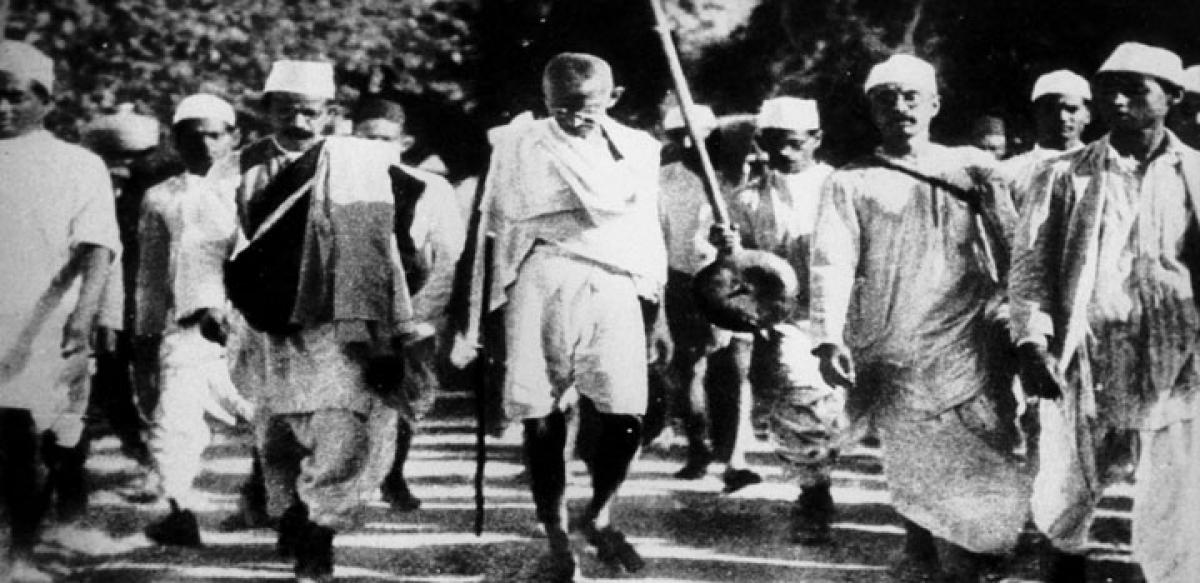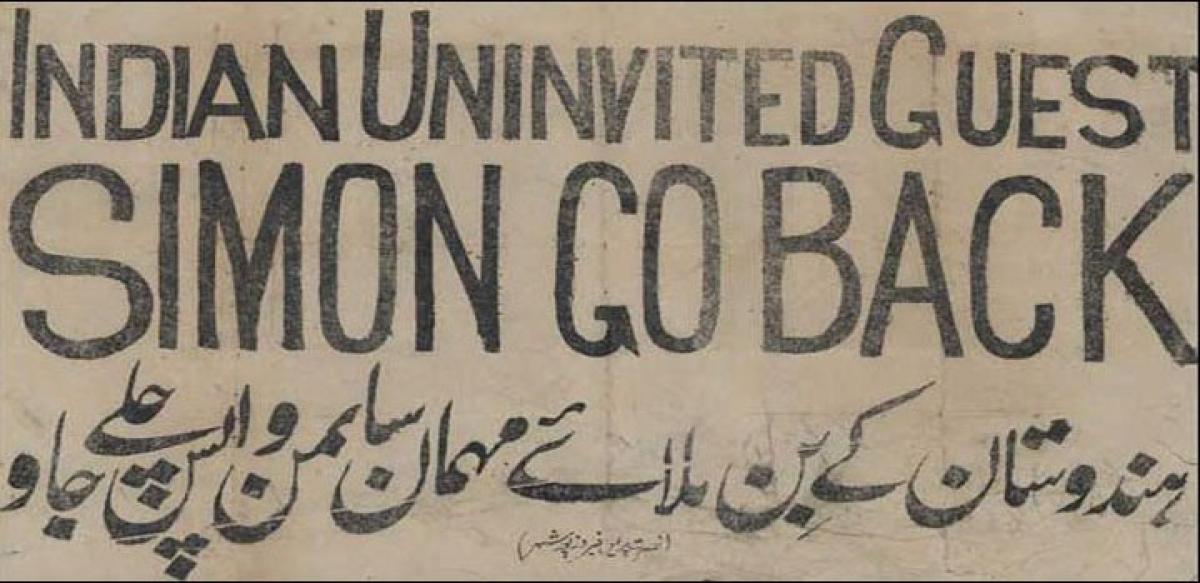Live
- VIP Treatment: Exclusive Benefits for High Rollers in Online Casino
- LS polls: Union Minister Bhagwanth Khuba, Dingaleshwara seer, Priyanka Jarkiholi file nominations in K'taka
- Amid show of strength, Congress’ Praniti Shinde files nomination from Solapur
- Tamil Nadu Police gives clean report to Isha Foundation in missing volunteers case
- Home Minister Amit Shah to address public meeting in Goa on April 24
- Gurgaon Open: M Dharma fires 67 for two-shot lead on penultimate day
- Sharad Pawar made many attempts to finish Shiv Sena, claims Maha minister
- Former England opener Raman Subba Row dies aged 92
- IPL 2024: Impact player rule is affecting the progress of half all-rounders, says Zaheer Khan
- ‘Teppa samudram’ review: Entertains with twists and turns
Just In

The third and final phase of the Nationalist Movement [1917-1947] is known as the Gandhian era. During this period Mahatma Gandhi became the undisputed leader of the National Movement. His principles of nonviolence and Satyagraha were employed against the British Government.
The third and final phase of the Nationalist Movement [1917-1947] is known as the Gandhian era. During this period Mahatma Gandhi became the undisputed leader of the National Movement. His principles of nonviolence and Satyagraha were employed against the British Government.

Gandhi made the nationalist movement a mass movement. Mohandas Karamchand Gandhi was born at Porbandar in Gujarat on 2 October 1869. He studied law in England. He returned to India in 1891. In April 1893 he went to South Africa and involved himself in the struggle against apartheid (Racial discrimination against the Blacks) for twenty years.
Finally, he came to India in 1915. Thereafter, he fully involved himself in the Indian National Movement. Mahatma Gandhi began his experiments with Satyagraha against the oppressive European indigo planters at Champaran in Bihar in 1917.
In the next year he launched another Satyagraha at Kheda in Gujarat in support of the peasants who were not able to pay the land tax due to failure of crops. During this struggle, Sardar Vallabhai Patel emerged as one of the trusted followers of Gandhi.
In 1918, Gandhi undertook a fast unto death for the cause of Ahmedabad Mill Workers and finally the mill owners conceded the just demands of the workers. On the whole, the local movements at Champaran, Kheda and Ahmedabad brought Mahatma Gandhi closer to the life of the people and their problems at the grass roots level. Consequently, he became the leader of the masses.
The Rowlet Act, Jallianwala Bagh Massacre and Khilafat Movement
In 1917, a committee was set up under the presidentship of Sir Sydney Rowlatt to look into the militant Nationalist activities. On the basis of its report the Rowlatt Act was passed in March 1919 by the Central Legislative Council.
As per this Act, any person could be arrested on the basis of suspicion. No appeal or petition could be filed against such arrests. This Act was called the Black Act and it was widely opposed. An all-India hartal was organized on 6 April 1919. Meetings were held all over the country.
Mahatma Gandhi was arrested near Delhi. Two prominent leaders of Punjab, Dr Satya Pal and Dr. Saifuddin Kitchlew, were arrested in Amritsar.
Jallianwala Bagh Massacre (13 April, 1919)
The Jallianwala Bagh Massacre took place on 13 April 1919 and it remained a turning point in the history of India’s freedom movement. In Punjab, there was an unprecedented support to the Rowlatt Satyagraha.
Facing a violent situation, the Government of Punjab handed over the administration to the military authorities under General Dyer. He banned all public meetings and detained the political leaders. On 13th April, the Baisakhi day (harvest festival), a public meeting was organized at the Jallianwala Bagh (garden).
Dyer marched in and without any warning opened fire on the crowd. The firing continued for about 10 to 15 minutes and it stopped only after the ammunition exhausted. According to official report 379 people were killed and 1137 wounded in the incident.
There was a nationwide protest against this massacre and Rabindranath Tagore renounced his knighthood as a protest. The Jallianwala Bagh massacre gave a tremendous impetus to the freedom struggle.
Khilafat Movement
The chief cause of the Khilafat Movement was the defeat of Turkey in the First World War. The harsh terms of the Treaty of Sevres (1920) was felt by the Muslims as a great insult to them.
The whole movement was based on the Muslim belief that the Caliph (the Sultan of Turkey) was the religious head of the Muslims all over the world. The Muslims in India were upset over the British attitude against Turkey and launched the Khilafat Movement.
Maulana Abul Kalam Azad, M.A. Ansari, Saifuddin Kitchlew and the Ali brothers were the prominent leaders of this movement. A Khilafat Committee had been formed and on 19th October 1919, the whole country had observed the Khilafat day.
On 23 November, a joint conference of the Hindus and the Muslims had also been held under the chairmanship of Mahatma Gandhi. Mahatma Gandhi was particularly interested in bringing the Hindus and the Muslims together to achieve the country’s independence.
Subsequently, the Khilafat Movement merged with the Non-Cooperation Movement launched by Mahatma Gandhi in 1920.
Non-Cooperation Movement (1920-1922)
Mahatma Gandhi announced his plan to begin Non-Cooperation with the government as a sequel to the Rowlatt Act, Jallianwala Bagh massacre and the Khilafat Movement. It was approved by the Indian National Congress at the Nagpur session in December, 1920.
Programmes
The programmes of the Non-Cooperation Movement were:
Surrender of titles and honorary positions.
Resignation of membership from the local bodies.
Boycott of elections held under the provisions of the 1919 Act.
Boycott of government functions.
Boycott of courts, government schools and colleges.
Boycott of foreign goods.
Establishment of national schools, colleges and private panchayat courts.
Popularizing swadeshi goods and khadi (Home spun cloth).
The movement began with Mahatma Gandhi renouncing the titles, which were given by the British. Other leaders and influential persons also followed him by surrendering their honorary posts and titles. Students came out of the government educational institutions.
National schools such as the Kashi Vidyapeeth, the Bihar Vidyapeeth and the Jamia Millia Islamia were set up. All the prominent leaders of the country gave up their lucrative legal practice. Legislatures were boycotted. No leader of the Congress came forward to contest the elections for the Legislatures.
In 1921, mass demonstrations were held against the Prince of Wales during his tour of India. The government resorted to strong measures of repression. Many leaders were arrested. The Congress and the Khilafat Committees were proclaimed as illegal. At several places, bonfires of foreign clothes were organised.
The message of Swadeshi spread everywhere. Most of the households took to weaving cloths with the help of charkhas. But the whole movement was abruptly called off on 11th February 1922 by Gandhi following the Churi Chaura incident in the Gorakpur district of U.P.
Earlier on 5th February an angry mob set fire to the police station at Churi Chaura and twenty two police men were burnt to death. Many top leaders of the country were stunned at this sudden suspension of the Non-Cooperation Movement. Mahatma Gandhi was arrested on 10 March 1922.
Significance of the Non-Cooperation Movement
1.It was the real mass movement with the participation of different sections of Indian society such as peasants, workers, students, teachers and women.
2.It witnessed the spread of nationalism to the remote corners of India.
3.It also marked the height of Hindu-Muslim unity as a result of the merger of Khilafat movement.
4.It demonstrated the willingness and ability of the masses to endure hardships and make sacrifices.
Swaraj Party and Simon Commission (1927)
The suspension of the Non-Cooperation Movement led to a split within Congress in the Gaya session of the Congress in December 1922. Leaders like Motilal Nehru and Chittranjan Das formed a separate group within the Congress known as the Swaraj Party on 1 January 1923.
The Swarajists wanted to contest the council elections and wreck the government from within. Elections to Legislative Councils were held in November 1923. In this, the Swaraj Party gained impressive successes. In the Central Legislative Council Motilal Nehru became the leader of the party whereas in Bengal the party was headed by C.R. Das.
The Swaraj Party did several significant things in the Legislative Council. It demanded the setting up of responsible government in India with the necessary changes in the Government of India Act of 1919. The party could pass important resolutions against the repressive laws of the government.
When a Committee chaired by the Home Member, Alexander Muddiman considered the system of Dyarchy as proper, a resolution was passed against it in the Central Legislative Council. After the passing away of C.R. Das in June 1925, the Swarj Party started weakening.
The Act of 1919 included a provision for its review after a lapse of ten years. However, the review commission was appointed by the British Government two years earlier of its schedule in 1927. It came to be known as Simon Commission after the name of its chairman, Sir John Simon.
All its seven members were Englishmen. As there was no Indian member in it, the Commission faced a lot of criticism even before its landing in India. Almost all the political parties including the Congress decided to oppose the Commission.
On the fateful day of 3 February 1928 when the Commission reached Bombay, a general hartal was observed all over the country. Everywhere it was greeted with black flags and the cries of ‘Simon go back’. At Lahore, the students took out a large anti-Simon Commission demonstration on 30 October 1928 under the leadership of Lala Lajpat Rai.
In this demonstration, Lala Lajpat Rai was seriously injured in the police lathi charge and he passed away after one month. The report of the Simon Commission was published in May 1930. It was stated that the constitutional experiment with Dyarchy was unsuccessful and in its place the report recommended the establishment of autonomous government.
There is no doubt that the Simon Commission’s Report became the basis for enacting the Government of India Act of 1935.
Source: http://holisticthought.com/indian-national-movement-1917-1947

© 2024 Hyderabad Media House Limited/The Hans India. All rights reserved. Powered by hocalwire.com







